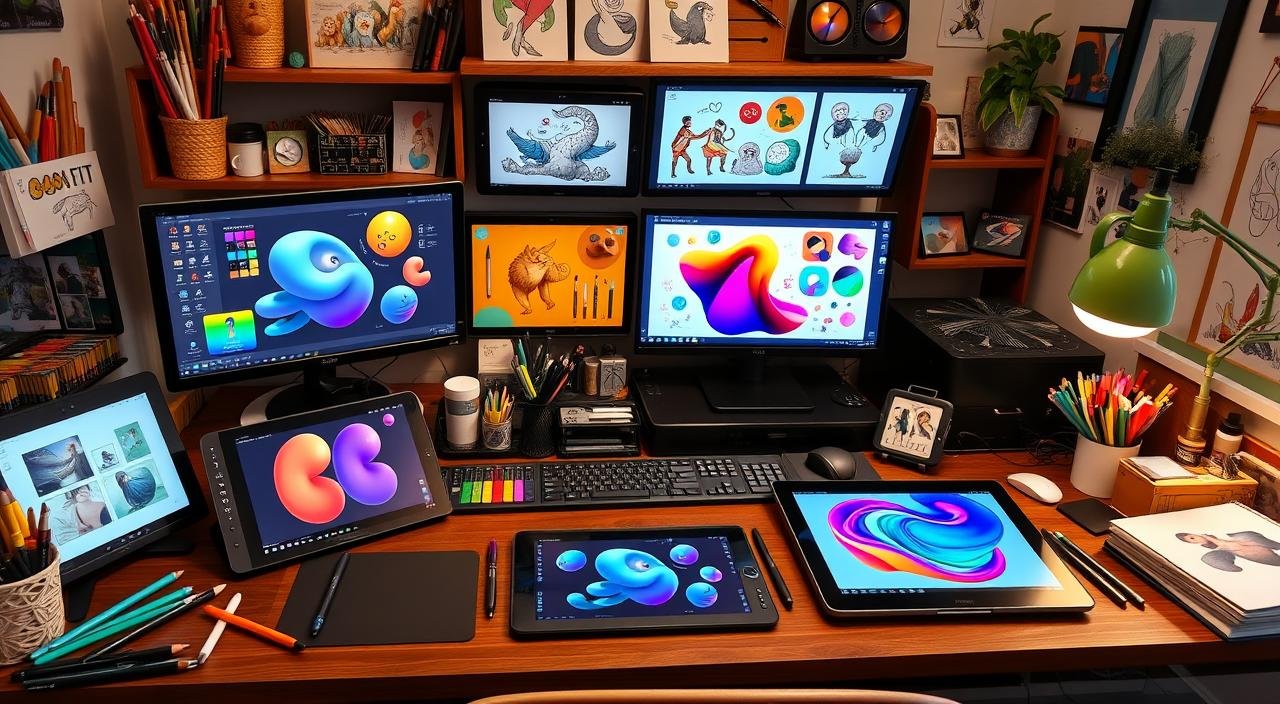The world of illustration has changed a lot in the digital age. Digital illustration is now a popular choice for both new and experienced artists. It lets them make amazing visuals that grab people’s attention and explore new creative ways.
Digital illustration opens up many exciting areas, from realistic paintings to dreamlike and abstract works. Artists can use digital tools to improve and change their art. This mix of old and new techniques lets them create something truly special. This guide will show you the basics and tools to take your digital art to the next level.
Key Takeaways
- Digital art includes many types, like painting, drawing, photography, and animation.
- Digital tools and software give artists full control over colors, textures, and lights. This opens up endless creative options.
- Digital art lets artists try out different styles and techniques without the limits of physical materials.
- Digital art is all about the artist’s creativity and skill. Digital tools are just a way to express that.
- The need for talented digital artists is growing in fields like animation, video games, and graphic design.
Understanding the Fundamentals of Digital Art Creation
The world of digital art is full of possibilities for artists. With digital illustrator tools, you can create without limits. You can make vibrant digital paintings or detailed graphic tablet drawings.
Essential Hardware and Software Requirements
To start your digital art journey, you need the right tools. A strong computer or tablet, a drawing tablet or graphic tablet, and a stylus are key. Illustration software like Adobe Photoshop and Procreate offer many brushes and textures.
Also Read: GAP Insurance Explained: Protecting Your Car Investment
Basic Digital Art Concepts and Terminology
Knowing the basics of digital art is important. Learn about bitmap (raster) graphics and vector graphics. Understanding layers, blending modes, and color theory will help you create your vision.
Choosing the Right Digital Tools for Your Style
Choosing the right digital tools is crucial for your style. Think about your budget, what platform you use, and what features you need. Whether you choose a drawing tablet or an iPad, the right software program is key.
To succeed as a digital illustrator, learn the basics, try different tools, and practice often. Embracing digital art opens up a world of possibilities. It lets you express your creativity like never before.
Also Read: Building Bridges: University Networking Event For Students And Alumni
Digital Illustration Tools and Software Mastery

Digital art uses many tools and software, each with its own strengths. These tools help artists create amazing vector, concept art, and digital illustration styles. Knowing how to use these tools is key to making great art.
Corel Painter is a top choice for digital painting. It mimics traditional media like oils and watercolors. With its advanced brushes and huge library, artists can explore many illustration styles and create art in new ways.
Adobe Illustrator and Inkscape are great for vector illustration. They let artists make graphics and illustrations that can be scaled up or down. These tools are perfect for logos and branding because they offer precise, resizable elements.
For 3D modeling and sculpting, Autodesk Maya and ZBrush are top picks. They help artists create detailed three-dimensional objects and scenes. These programs let artists turn their concept art and digital illustration styles into immersive, three-dimensional worlds.
Also Read: African Art Museum: Celebrating Heritage And Creativity
Learning to use these different digital illustration tools is vital for digital artists. It lets them work in various styles and mediums, opening up more creative possibilities and career paths.
“The mastery of digital illustration tools and software is not just a technical skill, but a gateway to unleashing boundless creative potential.”
Advanced Techniques and Creative Workflows

Digital artists need to master advanced techniques to improve their work. The process of digital illustration includes many steps. These range from research and planning to the actual painting.
Understanding layering and composition can make illustrations stand out. It turns simple designs into stunning works of art.
Layering and Composition Strategies
Skilled artists use layering to organize their work. This lets them arrange elements on different layers. They can then adjust and refine their designs easily.
Using the rule of thirds and leading lines adds depth. It also guides the viewer’s eye through the artwork.
Also Read: How Collision Insurance Works After An Accident
Color Theory and Palette Development
Learning color theory helps artists create harmonious palettes. They can experiment with colors to make their illustrations pop. Choosing colors wisely and blending them adds depth to the artwork.
Texture and Lighting Effects
Adding textures and lighting effects brings illustrations to life. Artists use techniques like line work and shading to add depth. Blending colors and using digital effects enhance the artwork’s appeal.
Also Read: University Admissions: A Step-by-Step Guide
By focusing on movement and fluidity, artists can make their work dynamic. This adds energy to their illustrations.
“The most important thing is to enjoy your work, to be inspired by what you’re doing. If you’re not enjoying it, it’s going to show in the end product.”
Also Read: The Different Types of Art Schools Explained
Building Your Professional Digital Art Portfolio
Creating a strong digital illustration portfolio is key for artists starting their career. It helps them show their work and find jobs in the field. A good portfolio should have high-quality images of your best work, along with artist statements and contact info.
Using social media like Instagram, Twitter, and ArtStation can help artists grow their brand. They can share their work and connect with more people. It’s important to keep practicing, trying new styles, and staying up-to-date with trends.
For artists starting or looking to switch to digital illustration, a strong portfolio is essential. By showing your best work, you can highlight your skills and passion. This can lead to better job opportunities and help you grow in your career.
FAQs
Q: What skills do I need to become a digital illustrator?
A: To become a digital illustrator, you should develop strong drawing skills, familiarize yourself with various illustration software such as Adobe Photoshop and vector illustration tools, and understand the basics of art and design. Additionally, learning about different digital techniques and styles can enhance your work.
Q: What types of digital illustration jobs are available?
A: There are various types of digital illustration jobs available, including book cover design, fashion illustration, advertising, and character design for video games. Many illustrators also work freelance or find work as a digital illustrator in web development and graphic design.
Q: Can I become a digital illustrator without a degree?
A: Yes, you can become a digital illustrator without a degree. Many successful digital illustrators are self-taught or have completed online courses and tutorials that help them build their skills and create a portfolio.
Q: What is the best software for digital illustration?
A: Popular software for digital illustration includes Adobe Photoshop, Adobe Illustrator for vector illustrations, and other illustration software like Procreate and Clip Studio Paint. The choice of software often depends on the type of illustration you wish to create.
Q: How can I create a digital illustration portfolio?
A: To create a digital illustration portfolio, gather your best work and showcase a variety of styles and types of illustration. Include projects that highlight your skills in digital techniques, and consider using a personal website or platforms like Behance to display your portfolio.
Q: Are there online courses available for digital illustration?
A: Yes, there are many online courses and tutorials available for aspiring digital illustrators. These courses often cover various topics, including the basics of illustration, specific software tutorials, and guidance on developing your unique illustration style.
Q: What are the popular digital illustration styles?
A: Some popular digital illustration styles include flat design, 3D illustration, minimalistic styles, and fashion illustration. Understanding these styles can help you determine which type of illustration best suits your interests and skills.
Q: How do I find work as a digital illustrator?
A: To find work as a digital illustrator, start by building a strong portfolio and networking with other professionals in the field. You can also look for digital illustration jobs on freelance platforms, social media, and job boards that specialize in design and illustration opportunities.
Q: What tools do I need to create digital illustrations?
A: Essential tools for creating digital illustrations include a graphics tablet for precise drawing, illustration software like Adobe Photoshop or Illustrator, and a reliable computer. Additionally, having access to online tutorials and resources can help you improve your skills further.
Source Links
-
- https://www.doodlersanonymous.com/exploring-digital-art-techniques-and-tools/
- https://designpalette.org/digital-art-techniques/
- https://www.blackillustrations.com/blog/how-to-become-a-quality-illustrator-a-guide-to-successful-digital-illustration
- https://www.digitalartsblog.com/tips/digital-illustration-beginners-ultimate-guide





